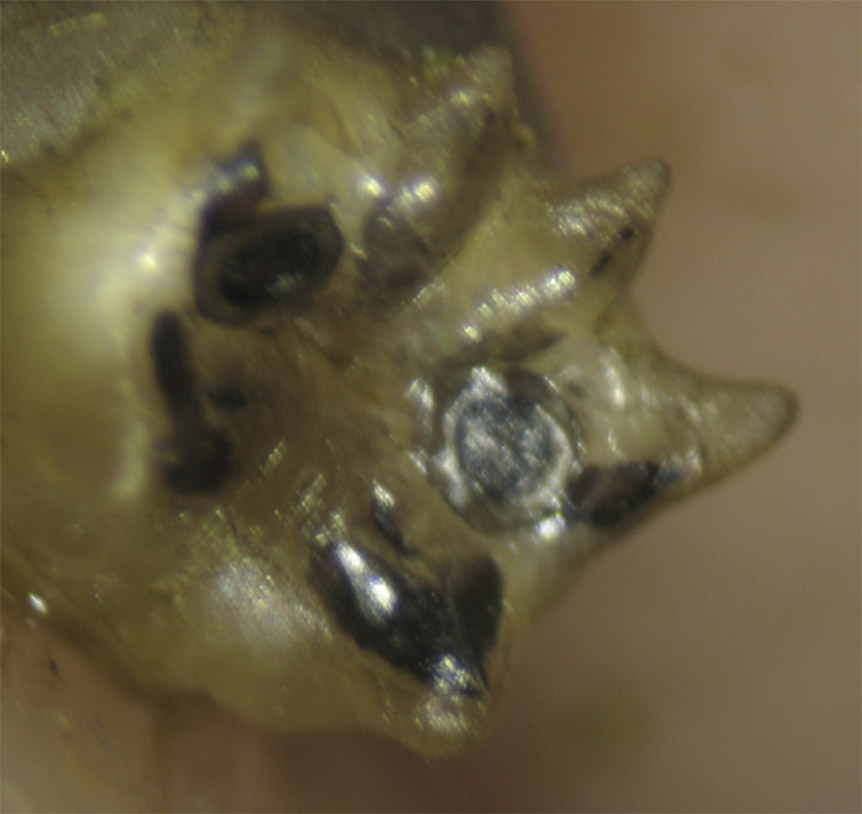Diptera.info :: Identification queries :: Diptera (eggs, larvae, pupae)
|
Tipula (Savtshenkia) signata larva
|
|
| Cranefly |
Posted on 20-01-2010 12:20
|
|
Member Location: Shachovskaya Posts: 647 Joined: 17.09.08 |
This is the second larva from the same place. I discovered this aquatic larva in May in very quick stream (1 m/s) inside algae. I made photo of alive larva and then tried to rear it. No success of course. No larger larvae or pupae in this place or in wet moss around the stream. Smolensk region. The question is - is it possible to determine it? The second - how to rear aquatic larvae in this case? Cranefly attached the following image:  [103.77Kb] Edited by Cranefly on 21-01-2010 10:33 |
|
|
|
| Paul Beuk |
Posted on 21-01-2010 09:40
|
|
Super Administrator Location: Netherlands Posts: 19403 Joined: 11.05.04 |
The closest I get with Theowald's work is Tipula (Mediotipula) stigmatella Schummel, 1833, but I don't think it is that one. I assume there are no other pictures here as well?
Paul - - - - Paul Beuk on https://diptera.info |
| atylotus |
Posted on 21-01-2010 09:41
|
|
Member Location: Amsterdam, NL Posts: 1172 Joined: 29.05.09 |
Most diagnostic details are hard to see, even the photo is too blurry, but it is a Tipula spec. To give a species name I need information like the shape and number of the anal tubules. In aquatic systems Tipula (Yamatotipula) and T. (Acutipula) are most common. Other (semi-) aquatic species are T. (Schumellia) variicornis, T. (Savtshenkia) spec., T. (Mediotipula) spec. and occasionally in moors T. (Platytipula). When I only look at the colouration of the lobes than it resembles a T. (Savtchenkia) signata, but I'm not quit sure (even about the subgenus) without having a look at the anal tubules. |
|
|
|
| Cranefly |
Posted on 21-01-2010 09:49
|
|
Member Location: Shachovskaya Posts: 647 Joined: 17.09.08 |
I had a seria of 4 larvae here so managed to keep one of the in alhogol. I'll try to attach more photoe
Cranefly attached the following image:  [177.11Kb] |
|
|
|
| Paul Beuk |
Posted on 21-01-2010 10:00
|
|
Super Administrator Location: Netherlands Posts: 19403 Joined: 11.05.04 |
These images would indeed be more supportive for Tipula (Savchenkia) signata (still in subgenus Oreomyza in Theowald's 1957 work).
Paul - - - - Paul Beuk on https://diptera.info |
| atylotus |
Posted on 21-01-2010 10:20
|
|
Member Location: Amsterdam, NL Posts: 1172 Joined: 29.05.09 |
To me it looks very like Tipula (Savtshenkia) signata. This species occurs in moss near brooks. When I look at the small photo at the right side, I'll see four pairs of anal tubules. This is characteristic for the subgenus. In other subgenera there are at most three pairs. The colouration of the lobes is similar of that of signata, although I cannot be 100% sure that you have other species similar of signata in that area.
Edited by atylotus on 21-01-2010 10:21 |
|
|
|
| Cranefly |
Posted on 21-01-2010 10:22
|
|
Member Location: Shachovskaya Posts: 647 Joined: 17.09.08 |
Many thanks |
|
|
|
| atylotus |
Posted on 21-01-2010 11:06
|
|
Member Location: Amsterdam, NL Posts: 1172 Joined: 29.05.09 |
Came across these drawings in Tsalolikhin (ed.) 1999. Key to the freshwater invertebrates of Russia. I thought your larva also resembles fig. 7: T. glaucocinerea, and perhaps also even fig. 10, so care must be taken. EDIT Paul Beuk: Translated from Dutch to english. 
atylotus attached the following image:  [77.45Kb] Edited by Paul Beuk on 21-01-2010 11:28 |
|
|
|
| Cranefly |
Posted on 21-01-2010 16:10
|
|
Member Location: Shachovskaya Posts: 647 Joined: 17.09.08 |
Many thanks. No hope to rear it. The larva is conserved in absolute alcohol. I'll try to catch all imagoes living there and apply then to specialists in molecular genetics sometimes. |
|
|
|
| Cranefly |
Posted on 21-01-2010 16:14
|
|
Member Location: Shachovskaya Posts: 647 Joined: 17.09.08 |
This spring I could catch there only Tipula monthium or possibly some other species from lateralis group, laying eggs. |
|
|
|
| atylotus |
Posted on 21-01-2010 16:36
|
|
Member Location: Amsterdam, NL Posts: 1172 Joined: 29.05.09 |
the larva on the picture is definitely not one of the lateralis group, I know T. lateralis larva very well and this species (as well as in other lateralis group- species it has a black median dorsal stripe, occasionally interrupted, but there are always signs left of black dorsal pigmentation, even in juveniles. |
|
|
|
| Jump to Forum: |













